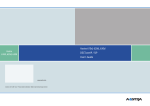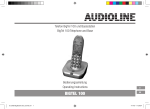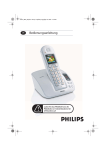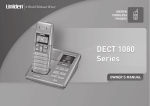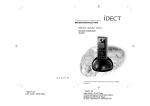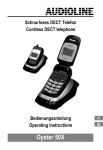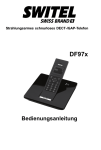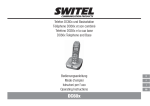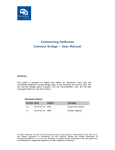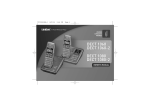Download Berlin 500 - Audioline
Transcript
Schnurloses DECT−Telefon
Cordless DECT telephone
Bedienungsanleitung
Operating Instructions
Berlin 500
Berlin 500
Bedienungsanleitung . . . . . . . . . . . . . . . . . . . . . . 3
Operating Instructions . . . . . . . . . . . . . . . . . . . . . 27
2
1
Inhaltsverzeichnis
1
2
3
4
5
6
7
8
9
10
11
12
13
Sicherheitshinweise . . . . . . . . . . . . . . . . . . . . . .
Telefon in Betrieb nehmen . . . . . . . . . . . . . . . . . .
Bedienelemente . . . . . . . . . . . . . . . . . . . . . . . . .
Wie bediene ich mein Telefon? . . . . . . . . . . . . . . .
Telefonieren . . . . . . . . . . . . . . . . . . . . . . . . . . . .
Nebenstellenanlagen / Zusatzdienste . . . . . . . . . .
Menüstruktur . . . . . . . . . . . . . . . . . . . . . . . . . . .
Besondere Funktionen . . . . . . . . . . . . . . . . . . . . .
Erweitern des Telefonsystems . . . . . . . . . . . . . . .
Falls es Probleme gibt . . . . . . . . . . . . . . . . . . . . .
Technische Eigenschaften . . . . . . . . . . . . . . . . . .
Pflegehinweise / Garantie . . . . . . . . . . . . . . . . . .
Stichwortverzeichnis . . . . . . . . . . . . . . . . . . . . . .
4
5
7
8
10
13
14
19
21
22
23
25
26
3
Sicherheitshinweise
1 Sicherheitshinweise
Lesen Sie diese Bedienungsanleitung sorgfältig durch.
Bestimmungsgemäße Verwendung
Dieses Telefon ist geeignet für das Telefonieren innerhalb eines Telefonnetzes. Jede
andere Verwendung gilt als nicht bestimmungsgemäß. Eigenmächtige Veränderungen
oder Umbauten sind nicht zulässig. Öffnen Sie das Gerät in keinem Fall selbst und führen Sie keine eigenen Reparaturversuche durch.
Aufstellungsort
Vermeiden Sie Belastungen durch Rauch, Staub, Erschütterungen, Chemikalien,
Feuchtigkeit, Hitze oder direkte Sonneneinstrahlung.
Verwenden Sie das Mobilteil nicht in explosionsgefährdeten Bereichen.
Netzteil
Achtung: Verwenden Sie nur das mitgelieferte Steckernetzteil, da andere
Netzteile das Telefon beschädigen können. Sie dürfen den Zugang zum Stekkernetzteil nicht durch Möbel oder andere Gegenstände versperren.
Aufladbare Akkus
Achtung: Werfen Sie Akkus nicht ins Feuer und tauchen Sie sie nicht ins Wasser.
Stromausfall
Bei Stromausfall kann mit dem Telefon nicht telefoniert werden. Halten Sie für Notfälle
ein schnurgebundenes Telefon bereit, welches ohne eine externe Stromversorgung arbeitet.
Medizinische Geräte
Achtung: Benutzen Sie das Telefon nicht in der Nähe von medizinischen Geräten. Eine Beeinflussung kann nicht völlig ausgeschlossen werden.
DECT1−Telefone können in Hörgeräten einen unangenehmen Brummton verursachen.
Entsorgung
Sie sind gesetzlich zur sachgerechten Entsorgung von Gebrauchsgütern verpflichtet. Das nebenstehende Symbol auf Ihrem Telefon bedeutet, dass elektrische und elektronische Altgeräte und Akkus getrennt vom Hausmüll zu entsorgen sind.
Elektrische oder elektronische Geräte entsorgen Sie bei einer Sammelstelle
eines geeigneten Entsorgungsträgers.
Akkus entsorgen Sie beim batterievertreibenden Handel sowie bei zuständigen Sammelstellen, die entsprechende Behälter bereitstellen.
Verpackungsmaterialien entsorgen Sie entsprechend den lokalen Vorschriften.
1 DECT: Digital Enhanced Cordless Telephone = Standard für kabellose Telefone.
4
Telefon in Betrieb nehmen
2 Telefon in Betrieb nehmen
Sicherheitshinweise
Achtung: Lesen Sie vor der Inbetriebnahme unbedingt die Sicherheitshinweise in Kapitel 1.
Verpackungsinhalt prüfen
Zum Lieferumfang gehören:
− eine Basisstation mit Netzteil
− ein Telefonanschlusskabel
− ein Mobilteil
− zwei Akkus
− eine Bedienungsanleitung
Basisstation anschließen
Achtung: Stellen Sie die Basisstation mit einem Mindestabstand von 1 m zu
anderen elektronischen Geräten auf, da es sonst zu gegenseitigen Störungen
kommen kann.
Schließen Sie die Basisstation wie auf der Skizze abgebildet an. Verwenden Sie aus Sicherheitsgründen nur das mitgelieferte Netzteil sowie das beigefügte Telefonanschlusskabel.
Telefonanschlussdose
Netzsteckdose
Akkus einlegen
Legen Sie die Akkus in das geöffnete Akkufach ein. Verwenden Sie nur Akkus des
Typs AAA Ni−MH 1,2 V. Achten Sie auf die
richtige Polung! Schließen Sie das Akkufach.
Akkus aufladen 2
Stellen Sie das Mobilteil bei der ersten Inbetriebnahme für mindestens 16 Stunden in
die Basisstation / Ladestation. Haben Sie das Mobilteil richtig in die Basisstation / Ladestation gestellt, leuchtet die Ladekontrollleuchte. Das Mobilteil erwärmt sich beim Laden.
Dies ist normal und ungefährlich. Laden Sie das Mobilteil nicht mit fremden Aufladegeräten. Der aktuelle Akkuladezustand wird im Display angezeigt:
Voll
Halb
Schwach
Leer
5
Telefon in Betrieb nehmen
Mobilteil aus− und einschalten
Um die Akkus zu schonen, können Sie das Mobilteil aus− und einschalten.
2 sec Mobilteil ausschalten
Mobilteil einschalten
Datum und Uhrzeit einstellen
Auf Seite 14 erfahren Sie, wie Sie bei der ersten Inbetriebnahme das Datum und die
Uhrzeit Ihres Mobilteils einstellen können.
Nebenstellenanlagen
Auf Seite 13 finden Sie weitere Informationen, falls Sie Ihr Telefon an einer Nebenstellenanlage anschließen möchten.
6
Bedienelemente
3 Bedienelemente
Mobilteil
1
2
3
4
5
6
Menütaste / OK−Taste
Aufwärts blättern / Wahlwiederholungsliste
Gespräch beenden / Mobilteil ein−, ausschalten
Abwärts blättern / Telefonbuch
Interngespräche
11
Anrufliste / R−Taste /
10
Konferenzgespräch starten
9
7 Raute−Taste / Tastensperre
8 Stern−Taste / Temporäre Tonwahl
9 Freisprechen
10 Gespräch annehmen
8
11 Löschen / Zurück
1
2
3
4
5
6
7
Basisstation
1
2
LED Ladekontrollleuchte
Paging−Taste (Mobilteil suchen)
1
2
Die Tasten werden in dieser Bedienungsanleitung mit einer einheitlichen Kontur abgebildet. Abweichungen von Tastensymbolen Ihres Telefons gegenüber den hier abgebildeten Tastensymbolen sind möglich.
7
Wie bediene ich mein Telefon?
4 Wie bediene ich mein Telefon?
Darstellungen und Schreibweisen
2 sec halten loslassen Nummern oder Buchstaben eingeben
Abgebildete Taste kurz drücken
Abgebildete Taste 2 Sekunden drücken
Abgebildete Taste halten
Abgebildete Taste loslassen
Mobilteil klingelt
Basisstation klingelt
Mobilteil aus der Basisstation nehmen
Mobilteil in die Basisstation stellen
Aus oder
Text oder Symbole im Display
Symbole im Display
Display
Berlin 500
1
22:15 02/05
Beschreibung
Name des Mobilteils Seite 15
Interne Rufnummer des Mobilteils Seite 10
Anzeige der Uhrzeit und des Datums Seite 14
Konstant: Anzeige der Batteriekapazität.
Blinkend: Laden Sie die Akkus.
Durchlaufende Segmente: Die Akkus werden geladen. Seite 5
Der Tonruf ist ausgeschaltet. Seite 14
Anrufbeantworter im Telefonnetz.
VMWI1 − Optionaler Service Ihres Netzbetreibers Seite 13
Konstant: Sie führen ein Gespräch.
Blinkend: Es erreicht Sie ein Anruf. Seite 10
Das Freisprechen ist aktiviert. Seite 12
Das Mikrofon ist stummgeschaltet. Seite 11
Konstant: Die Verbindung zur Basisstation ist gut.
Blinkend: Die Verbindung zur Basisstation ist nicht gut. Nähern Sie
sich der Basisstation.
Die Tastensperre ist aktiviert. Seite 12
Der Alarm ist aktiviert. Seite 14
Walkie Talkie Die Funktion Walkie Talkie ist aktiviert. Seite 16
1 VMWI: Visual Message Waiting Indication
8
Wie bediene ich mein Telefon?
Navigation im Menü
Alle Funktionen sind über unterschiedliche Menüs zu erreichen. Den Weg zur gewünschten Funktion entnehmen Sie der Menüstruktur. Seite 14
Hauptmenü öffnen
oder Gewünschtes Untermenü auswählen
Untermenü öffnen
oder Gewünschte Funktion auswählen
Funktion öffnen
oder Gewünschte Einstellung auswählen
Über Tastenfeld Nummern oder Buchstaben
eingeben
Eingaben bestätigen
eine Ebene zurück
Programmier− und Speichervorgänge abbrechen
und in den Standby−Modus zurückkehren
Jeder Vorgang wird automatisch abgebrochen, wenn innerhalb von 60 Sekunden keine Eingabe erfolgt.
Telefonbucheinträge erstellen − Beispiel 3
Wie Sie in den Menüs navigieren und Eingaben vornehmen ist hier anhand des Beispiels Telefonbucheinträge erstellen erklärt. Verfahren Sie bei allen Einstellungen wie
bei diesem Beispiel.
Telefonbuch öffnen
, oder Neuer Eintr , Funktion auswählen und bestätigen
<Eing Name> , Namen eingeben und bestätigen (max. 13 Stellen)
<Nr eingeben> , Rufnummer eingeben und bestätigen (max. 24
Ziffern)
9
Telefonieren
5 Telefonieren
Anruf annehmen
, oder Anruf annehmen
Gespräch beenden
oder Gespräch beenden
Anrufen
Rufnummer eingeben (max. 24 Ziffern)
Bei Falscheingabe letzte Ziffer löschen
Rufnummer wählen
Sie können auch zuerst die Gesprächstaste drücken und erhalten damit das
Freizeichen. Die eingegebenen Ziffern Ihrer gewünschten Rufnummer werden
sofort gewählt. Eine Korrektur einzelner Ziffern der Rufnummer ist bei dieser
Form des Gesprächaufbaus nicht möglich.
Wahlwiederholung
Die zuletzt gewählte Rufnummer wählen
, , oder Wahlwiederhlg , die zuletzt gewählte Rufnummer wird gewählt
Eine Rufnummer aus der Wahlwiederholungsliste wählen
Ihr Telefon speichert die 10 zuletzt gewählten Rufnummern in einer Wahlwiederholungsliste.
Wahlwiederholungsliste öffnen
oder , Eintrag auswählen und Verbindung herstellen
Eingegangene Anrufe zurückrufen
Ihr Telefon speichert 30 eingegangene Anrufe in einer Anrufliste.
Anrufliste öffnen
oder , Eintrag auswählen und Verbindung herstellen
Rufnummern aus dem Telefonbuch wählen
Sie müssen Rufnummern im Telefonbuch gespeichert haben. Seite 9 und 17
Telefonbuch öffnen
oder , Eintrag auswählen und Verbindung herstellen
Intern telefonieren 4
Interne Gespräche führen
Sie müssen zwei oder mehr Mobilteile (MT1, MT2, ...) an einer Basisstation angemeldet
haben, um interne, kostenlose Gespräche führen zu können.
MT1: , oder Interne Rufnummer des gewünschten Mobilteils
z. B. 2 , wählen
MT2: Internes Gespräch am anderen Mobilteil annehmen
MT1 / MT2: Internes Gespräch beenden
10
Telefonieren
Externe Gespräche intern weiterleiten
MT1: , oder z. B. 2 , MT2: MT1: Während des externen Gesprächs interne
Rufnummer wählen
Internes Gespräch am anderen Mobilteil annehmen
Gespräch weiterleiten
Sollte sich das gerufene Mobilteil nicht melden, können Sie sich das externe
Gespräch durch Drücken der Taste wieder zurückholen.
Konferenzgespräche führen
Ein externes Gespräch kann mit einem weiteren internen Gesprächspartner zum Konferenzgespräch geschaltet werden.
MT1: , oder Während des externen Gesprächs interne
z. B. 2 , Rufnummer wählen
MT2: Internes Gespräch am anderen Mobilteil annehmen
MT1: Konferenz starten
MT1 / MT2: Durch Auflegen eines internen Gesprächspartners
wird die Konferenz beendet
Einstellen der Hörerlautstärke
Sie können während eines Gesprächs die Lautstärke in 6 Stufen anpassen.
oder Gewünschte Lautstärke auswählen
Klang einstellen
Sie können während eines Telefongesprächs den Klang des Hörers ändern.
, oder Klang , Funktion öffnen
oder z. B.:
NORMAL , Gewünschten Klang auswählen
Mikrofon im Mobilteil stummschalten 5
Sie können während eines Telefongesprächs das Mikrofon des Mobilteils aus− und einschalten.
, oder Stumm ein , Mikrofon ausschalten (stummschalten)
, oder Mikrofon einschalten
Stumm aus , 11
Telefonieren
Anzeige der Gesprächsdauer
Während eines Gesprächs wird die Gesprächsdauer in Stunden, Minuten und Sekunden angezeigt.
Freisprechen 6
Nutzen Sie diese Funktion, um den Gesprächspartner über den Lautsprecher zu hören.
Freisprechen einschalten
Freispechen ausschalten
Tastensperre 7
Bei eingeschalteter Tastensperre können eingehende Anrufe wie gewohnt angenommen werden.
Tastensperre einschalten
2 sec 2 sec Tastensperre ausschalten
Mobilteil suchen (Paging)
Wenn Sie Ihr Mobilteil verlegt haben, können Sie es über einen Suchton leicht wiederfinden.
{«}
Suchton starten
oder Suchton beenden
12
Nebenstellenanlagen / Zusatzdienste
6 Nebenstellenanlagen / Zusatzdienste
R−Taste an Nebenstellenanlagen
Ist Ihr Telefon an einer Nebenstellenanlage angeschlossen, können Sie über die R−Taste Funktionen, wie z. B. Anrufe weiterleiten und automatischen Rückruf, nutzen. Lesen
Sie bitte in der Bedienungsanleitung Ihrer Nebenstellenanlage, welche Flash−Zeit Sie
zur Nutzung dieser Funktionen einstellen müssen. Ob Ihr Telefon an Ihrer Nebenstellenanlage einwandfrei funktioniert, erfahren Sie bei dem Händler, bei dem die Anlage gekauft wurde. Einstellen der Flash−Zeit Seite 16
Wahlpause
Bei Nebenstellenanlagen ist es erforderlich, eine Amtskennzahl vorzuwählen, um ein
Freizeichen zu bekommen. Bei wenigen, älteren Nebenstellenanlagen dauert es einige
Zeit, bis das Freizeichen zu hören ist. Für diese Nebenstellenanlagen kann nach der
Amtskennzahl eine Wahlpause eingefügt werden, um direkt weiter wählen zu können,
ohne das Freizeichen abzuwarten.
3 sec Wahlpause einfügen
Nach der Amtskennzahl wartet Ihr Telefon für eine bestimmte Zeit mit dem Wählen der
eigentlichen Rufnummer.
Die Pause kann auch bei der Eingabe von Rufnummern im Telefonbuch gespeichert werden.
R−Taste und Zusatzdienste
Ihr Telefon unterstützt Zusatzdienste Ihres Netzbetreibers, wie z. B. Makeln, Anklopfen
und Konferenz. Über die R−Taste können Sie diese Zusatzdienste nutzen. Bitte fragen
Sie Ihren Netzbetreiber, welche Flash−Zeit Sie zur Nutzung von Zusatzdiensten einstellen müssen. Zur Freischaltung von Zusatzdiensten wenden Sie sich bitte an Ihren Netzbetreiber. Einstellen der Flash−Zeit Seite 16
Rufnummernanzeige (CLIP1)
Wenn diese Funktion an Ihrer Telefonleitung zur Verfügung steht, wird Ihnen bereits die
Rufnummer des Anrufers angezeigt, wenn das Telefon klingelt. Hat der Anrufer das
Übertragen seiner Rufnummer unterdrückt, wird eine entsprechende Meldung angezeigt. Die Rufnummer kann nicht angezeigt und somit auch nicht in der Anrufliste gespeichert werden.
Die Rufnummernanzeige ist ein optionaler Service Ihres Netzbetreibers. Fragen Sie Ihren Netzbetreiber nach weiteren Informationen.
Anrufbeantworter im Telefonnetz 8
Wenn Ihr Netzbetreiber einen Anrufbeantworter im Telefonnetz für Sie bereitstellt, werden Sie mit einem Symbol (VMWI2) über neue Nachrichten informiert. Der Anrufbeantworter und die Information über neue Nachrichten mit einem Symbol sind optionale Services Ihres Netzbetreibers. Über diese Funktionen können Sie nur dann verfügen, wenn
Ihr Netzbetreiber diesen Service anbietet. Bitte fragen Sie Ihren Netzbetreiber nach weiteren Informationen.
1 CLIP: Calling Line Identification Presentation
2 VMWI: Visual Message Waiting Indication
13
Menüstruktur
7 Menüstruktur
Hauptmenü 9
In das Hauptmenü gelangen Sie durch Drücken der Taste .
Raumüberwach.
Ton Einstllng
Mobilteil 1
Mobilteil 2
Klingl Lautst
Klingelton
Töne
NDR 1 − 6 HOCH
Aus
Ruf Extern
Ruf Intern
Ruf Paging
Alarmton
Termin Ton
Taste
Bestätigung
Warnung
Anruf Wartet
Alarm Reichw
Tonwahl 1 − 4
Bolero
Morning
Wilhelm Tell
Pomp & Circu
Je Te Veux
ABC
Ton 1
Ton 2
Ton 3
Aus
An
Aus
An
Aus
An
Aus
An
Aus
10
Zeit u Alarm
Termin einst
Termin 1 − 5
Dat. Zeit
Alarm Einstll
ZeitDat Einst
14
An
Aus
Dat. Zeit
Aus
An Termin Name
Alarm Einstll
Menüstruktur
11
Autom Gespr 1 An
Aus
Display
Mobiltl Name
Gespr Display 2
Sprachwahl
Mobiltl Name
Zeit
Nummer
Englisch / Deutsch
Französisch / Italienisch
Niederländ. / Spanisch
12
Weitere Einst
Mobiltl Reset
Anmelden
Nein
Ja
Basis 1 − 4
Eing Basis PIN
Basis wählen Automat 3
Basis ...
Abmelden
Mobilteil
Mobilteil 1
Mobilteil ...
Basis 1
Basis ...
Basis
Basis
Einst
Persönl Anruf 4
Warten... Warten...
<Nr eingeben>
Mobilteil 1
Neuer Eintr
Mobilteil ...
<Nr eingeben>
Eintr Ändern
<Nr eingeben>
Eintr Löschen
Nein
Ja
Nein
Ja
Nein
Ja
Mobilteil 1
Mobilteil ...
Mobilteil 1
Mobilteil ...
1 Weitere Informationen zur automatischen Gesprächsannahme Seite 19.
2 Gesprächszeit oder Rufnummernanzeige während des Gesprächs.
3 Das Mobilteil sucht sich automatisch die nächstgelegene Basisstation mit der be-
sten Verbindung (automatische Wahl).
4 Weitere Informationen zum persönlichen Anruf Seite 20.
15
Menüstruktur
13
Ton Einstllng
Basis Reset
Klingl Lautst
NDR 1 − 6 HOCH
Aus
Klingelton
Tonwahl 1 − 9
Nein
Basis Reset
Voreinstll
Ja
Weitere
Wählverf
Flashzeit
Vorwahl 1
Anrufsperre 2
<Nr eingeben>
Basis PIN
PIN : 0000
Tonwahl
Impulswahl
80 ms, 100 ms,
120 ms, 180 ms,
250 ms, 300 ms,
600 ms, 800 ms
<Nr eingeben>
An
Aus
14
Walkie Talkie
GruppenID Eing 3 Aus
Klingl Lautst
Klingelton
NDR 1 − 6 HOCH
Aus
Tonwahl 1 − 4
Bolero
...
1 Weitere Informationen zur Vorwahl Seite 19.
2 Weitere Informationen zur Anrufsperre Seite 20.
3 An allen Mobilteilen muss die gleiche Gruppen ID eingegeben werden. Weitere In-
formationen zum Walkie Talkie Seite 19.
16
Menüstruktur
Telefonbuch 15
In das Telefonbuch gelangen Sie durch Drücken der Taste .
Eintrag 1
Eintrag 2
<Eing Name> 1
Neuer Eintr
<Nr eingeben>
Eintrag ...
<Eing Name> 1
Eintr Ändern
<Nr eingeben>
Kein VIP Ton 2
Tonwahl 1 − 4
Bolero
...
Kein VIP Ton 2
Tonwahl 1 − 4
Bolero
...
Speichern
Zurück
Speichern
Zurück
Eintrag Kop 3
Alle Kopier 3
Eintr Löschen
Nein
Ja
Information
... FreierSpch 4
1 Text eingeben: Die Zahlentasten sind mit Buchstaben beschriftet. Durch mehrmaliges Drücken der entsprechenden Taste können Buchstaben, Zahlen und Sonderzeichen eingegeben werden. Mit der Taste 1 können Sie Leerschritte eingeben. Mit der
Sterntaste können Sie zwischen Groß− und Kleinschreibung wechseln. Bewegen Sie
den Cursor mit der Abwärts−Taste nach rechts, um nacheinander Buchstaben der selben Taste einzugeben
2 Hier können Sie einem Telefonbucheintrag eine bestimmte Tonrufmelodie zuordnen. Ihr Mobilteil meldet sich dann bei eingehenden Anrufen dieses Anrufers mit der
eingestellten Tonrufmelodie. Für diese Funktion wird die Rufnummernanzeige
(CLIP5) benötigt. Die Rufnummernanzeige ist ein optionaler Service Ihres Netzbetreibers. Fragen Sie Ihren Netzbetreiber nach weiteren Informationen.
3 Wurde der Kopiervorgang an einem Mobilteil gestartet, klingelt das ausgewählte
Mobilteil auf den kopiert werden soll. Die Telefonbucheinträge werden kopiert, sobald
die Verbindung mit der Gesprächstaste hergestellt wurde.
4 Anzeige der freien Speicherplätze im Telefonbuch.
5 CLIP: Calling Line Identification Presentation
17
Menüstruktur
Anrufliste
In die Anrufliste gelangen Sie durch Drücken der Taste .
Eintrag 1
Eintrag 2
<Eing Name>
In Tlfb Spch
<Nr eingeben>
Kein VIP Ton
Tonwahl 1 − 4
Bolero
...
Eintrag ...
Verwende Nr
Eintr Löschen
Nein
Ja
Liste Löschen
Nein
Ja
Speichern
Zurück
Wahlwiederholung
In die Wahlwiederholungsliste gelangen Sie durch Drücken der Taste .
Eintrag 1
Eintrag 2
In Tlfb Spch
<Eing Name>
<Nr eingeben>
Eintrag ...
Kein VIP Ton
Tonwahl 1 − 4
Bolero
...
Verwende Nr
18
Löschen
Nein
Ja
Alle löschen
Nein
Ja
Speichern
Zurück
Besondere Funktionen
8 Besondere Funktionen
Automatische Gesprächsannahme
Haben Sie die Funktion aktiviert, wird ein Anruf automatisch beim Herausnehmen des
Mobilteils aus der Basisstation angenommen. Seite 15
Wahlverfahren
Sie können Ihr Telefon sowohl an den analogen Vermittlungsstellen (Impuls−Wahlverfahren) als auch an den neuen digitalen Vermittlungsstellen (Ton−Wahlverfahren) betreiben. Seite 16
Temporäre Tonwahl
Können Sie Ihr Telefon nur mit dem Impuls−Wahlverfahren betreiben, brauchen Sie nicht
auf die Vorteile des Ton−Wahlverfahrens (z. B.: Abfrage eines Anrufbeantworters im
Telefonnetz) zu verzichten. Während einer bestehenden Verbindung können Sie vorübergehend zum Ton−Wahlverfahren wechseln.
3 sec Während des Gesprächs drücken
Nach Gesprächsende wird wieder automatisch auf das Impuls−Wahlverfahren zurückgeschaltet.
Raumüberwachung
Diese Funktion können Sie nutzen, wenn Ihnen zwei Berlin 500−Mobilteile zur Verfügung stehen.
Stellen Sie über das Untermenü Raumüberwach." eine Verbindung zu einem anderen
Mobilteil her und legen Sie das Mobilteil in den Raum den Sie überwachen möchten.
Nehmen Sie das Gespräch am anderen Mobilteil an. Jetzt können Sie den Raum überwachen, solange die Verbindung aufrecht erhalten wird.
Walkie Talkie 16
Diese Funktion können Sie nutzen, wenn Ihnen zwei Berlin 500−Mobilteile (MT1, MT2,
...) zur Verfügung stehen.
Sie müssen die Funktion an allen beteiligten Mobilteilen aktivieren Seite 16. Bei dieser Funktion arbeiten die Mobilteile unabhängig von der Basisstation. Während der Nutzung der Funktion können keine externen Anrufe an den Mobilteilen getätigt oder angenommen werden.
z. B.: MT 1: Mobilteile Rufen
z. B.: MT 2: Gespräch annehmen
MT 1/MT 2: Gespräch beenden
Vorwählen 17
Bei der Funktion können Sie automatisch eine Nummer vor der eigentlichen Rufnummer
vorwählen lassen. Dieses findet hauptsächlich Anwendung bei Call−by−Call−Nummern.
Sie können eine Call−by−Call−Nummer mit 24 Ziffern speichern. Die automatisch vorgewählte Call−by−Call−Nummer wird nicht vor der gewählten Rufnummer im Display angezeigt.
Wenn Sie zuerst die Gesprächstaste drücken, um ein Freizeichen zu hören und dann
eine Rufnummer eingeben, wird die gespeicherte Call−by−Call−Nummer ebenfalls vorgewählt.
19
Besondere Funktionen
Anrufsperre 18
Mit der Funktion können Sie Rufnummern oder Vorwahlnummern sperren. Die eingebene Anrufsperre gilt für alle angemeldeten Mobilteile. Notrufnummern können nicht
gesperrt werden.
Anrufsperre − Beispiele
0
Alle Ferngespräche sind gesperrt.
00
Alle Auslandsgespräche sind gesperrt.
017
Mobiltelefonnummern die mit 017" beginnen sind gesperrt.
019
Rufnummern die mit 019" beginnen sind gesperrt.
Termin einstellen
Mit dieser Funktion können Sie sich von Ihrem Mobilteil an einen Termin (z. B.: Geburtstage, Besprechungen) erinnern lassen Seite 14. Sie können 5 Termine mit dazugehörigem Namen speichern.
Alarm
Mit dieser Funktion können Sie sich zu einer bestimmten Zeit von Ihrem Mobilteil
wecken lassen. Seite 14
Persönlicher Anruf 19
Sie können insgesamt 10 persönliche Rufnummern speichern. Haben Sie für ein Mobilteil eine persönliche Rufnummer gespeichert, wird bei einem Anruf dieser Rufnummer
nur dieses eine Mobilteil klingeln. In allen anderen Berlin 500−Mobilteilen erscheint die
Meldung Privat Anruf . Die Annahme des Gesprächs ist dennoch an allen Mobilteilen
möglich.
20
Erweitern des Telefonsystems
9 Erweitern des Telefonsystems
Über den international genormten GAP1 Standard ist die Kompatibilität von Mobilteilen
und Basisstationen verschiedener Hersteller geregelt. So ist es möglich AUDIOLINE−
Geräte und Geräte anderer Hersteller zusammen in einem Telefonsystem zu integrieren. Es ist jedoch möglich, dass einige Funktionen nicht zur Verfügung stehen.
Mehrere Mobilteile
Sie können insgesamt 6 Mobilteile an Ihre Basisstation anmelden.
Anmelden von Mobilteilen
Bevor Sie den Anmeldevorgang eines Mobilteils durchführen, setzen Sie die jeweilige
Basisstation in den Registriermodus.
3 sec Registriermodus starten
Führen Sie jetzt den Anmeldevorgang an Ihrem Mobilteil durch Seite 15. Benutzen
Sie zur Anmeldung den aktuell eingestellten PIN−Code Seite 16.
Nach dem Anmelden wird dem Mobilteil eine interne Rufnummer gegeben. Diese interne Rufnummer wird im Display angezeigt.
Um Mobilteile anderer Hersteller anzumelden, lesen Sie bitte deren Bedienungsanleitungen.
Abmelden von Mobilteilen
Sie können ein Mobilteil von einer Basisstation nur durch ein weiteres an dieser
Basisstation angemeldetes Mobilteil abmelden.
Mehrere Basisstationen
Ihre Mobilteile können gleichzeitig an 4 verschiedenen Basisstationen angemeldet sein.
Jede Basisstation benötigt eine eigene Telefonsteckdose. Es können Anschlüsse mit
der selben und auch mit unterschiedlichen Rufnummern sein.
Laufende Gespräche können nicht von einer zur anderen Basisstation übertragen werden.
Erhöhung der Reichweite
Platzieren Sie die Basisstationen so, dass sich die Reichweite der einzelnen Basisstationen überschneidet. Testen Sie die Reichweite Ihrer Mobilteile, da Hindernisse in Gebäuden die Reichweite einschränken. Melden Sie das Mobilteil an alle Basisstationen
an. Schalten Sie die Funktion automatische Wahl von Basisstationen ein Seite 15.
Das Mobilteil sucht sich automatisch die nächstgelegene Basisstation mit der besten
Verbindung.
Mobilität durch verschiedene Standorte
Melden Sie das Mobilteil an verschiedenen Standorten an Basisstationen an. Schalten
Sie die Funktion automatische Wahl von Basisstationen ein Seite 15. An welchem
Standort Sie sich auch befinden, das Mobilteil sucht sich automatisch eine in Reichweite
liegende Basisstation.
1 GAP: Generic Access Profile = Standard für das Zusammenwirken von Mobilteilen
und Basisstationen anderer Hersteller.
21
Falls es Probleme gibt
10 Falls es Probleme gibt
Haben Sie Probleme mit Ihrem Telefon, kontrollieren Sie zuerst die folgenden Hinweise.
Bei Garantieansprüchen wenden Sie sich an Ihren Fachhändler.
Fragen und Antworten
Fragen
Keine Verbindung zur Basisstation möglich
Antworten
− Prüfen Sie, ob Sie sich mit dem richtigen PIN−
Code an der Basisstation angemeldet haben.
Seite 15
Kein Telefongespräch möglich
− Die Telefonleitung ist nicht korrekt angeschlossen oder gestört. Verwenden Sie nur das mitgelieferte Telefonanschlusskabel.
− Testen Sie mit einem anderen Telefon, ob Ihr
Telefonanschluss in Ordnung ist.
− Das Netzteil ist nicht eingesteckt oder es liegt
ein totaler Stromausfall vor.
− Die aufladbaren Akkus sind leer oder defekt.
− Sie haben sich zu weit von der Basisstation
entfernt.
− Sie haben die Rufnummer gesperrt (Anrufsperre) Seite 20
Verbindung abgehackt, fällt aus
− Sie haben sich zu weit von der Basisstation
entfernt.
− Falscher Aufstellungsort der Basisstation.
Das System reagiert nicht mehr
− Ziehen Sie kurzzeitig das Netzteil aus der
Steckdose.
− Stellen Sie die Werkseinstellungen wieder her.
Seite 23
− Die Akkus sind defekt.
− Stellen Sie das Mobilteil richtig auf die Basisstation. Reinigen Sie die Kontaktflächen am
Mobilteil und an der Basisstation mit einem weichen, trockenen Tuch.
− Stellen Sie das Mobilteil für 14 Stunden in die
Basisstation.
Die Akkus sind in kürzester Zeit
leer
Die Rufnummernanzeige
(CLIP1) funktioniert nicht
− Die Rufnummernanzeige ist ein Zusatzdienst
Ihres Netzbetreibers. Bitte fragen Sie Ihren
Netzbetreiber nach weiteren Informationen.
− Der Anrufer hat das Übertragen seiner Rufnummer unterdrückt.
1 CLIP: Calling Line Identification Presentation
22
Technische Eigenschaften
11 Technische Eigenschaften
Technische Daten
Merkmal
Wert
Standard
DECT1−GAP2
Stromversorgung
Eingang: 220/230 V, 50 Hz
Ausgang: 6 V, 400 mA
Reichweite
Außen: ca. 300 m
Innen: ca. 50 m
Standby
bis zu 125 h
Max. Gesprächsdauer
bis zu 13 h
Akkus
2 x AAA Ni−MH 1,2 V
Wahlverfahren
Ton−Wahlverfahren
Zulässige Umgebungstemperatur
10°C bis 30°C
Zulässige relative Luftfeuchtigkeit
20% bis 75%
Flash−Funktion
80 ms, 100 ms, 120 ms,
180 ms, 250 ms, 300 ms,
600 ms, 800 ms
Werkseinstellungen wiederherstellen 20
Mobilteil
Beim Reset werden Einträge im Telefonbuch nicht gelöscht.
Hauptmenü öffnen
oder Weitere Einst
,
Menü auswählen und bestätigen
oder Mobiltl Reset , Untermenü auswählen und bestätigen
oder Nein oder Ja , Reset abbrechen oder bestätigen
Basisstation
oder Basis Einst
oder Basis Reset
Hauptmenü öffnen
,
,
oder Nein oder Ja , Menü auswählen und bestätigen
Untermenü auswählen und bestätigen
Reset abbrechen oder bestätigen
1 DECT: Digital European Cordless Telephone = Standard für kabellose Telefone.
2 GAP: Generic Access Profile = Standard für das Zusammenwirken von Mobilteilen
und Basisstationen anderer Hersteller.
23
Technische Eigenschaften
Werkseinstellungen Mobilteil / Basisstation
Alarm: Aus
Klingl Lautst: 3
Termin: Aus
Klingelton > Ruf Extern: 1
Autom Gespr: An
Klingelton > Ruf Intern: 2
Sprachwahl: Deutsch
Klingelton > Ruf Paging: 3
Basis wählen: Automat
Klingelton > Alarmton: 3
Walkie Talkie > GruppenID Eing: 000
Klingelton > Termin Ton: 3
Flashzeit: 100 ms
Töne > Taste: 1
Basis PIN: 0000
Töne > Bestätigung: An
Vorwahl: Leer
Töne > Warnung: An
Anrufsperre: Leer
Töne > Anruf Wartet: An
Persönl Anruf: Leer
Töne > Alarm Reichw: An
Konformitätserklärung
Dieses Gerät erfüllt die Anforderungen der EU−Richtlinie:
1999/5/EG Richtlinie über Funkanlagen und Telekommunikationsendeinrichtungen und die gegenseitige Anerkennung ihrer Konformität. Die Konformität
mit der o. a. Richtlinie wird durch das CE−Zeichen auf dem Gerät bestätigt.
Für die komplette Konformitätserklärung nutzen Sie bitte den kostenlosen
Download von unserer Website www.audioline.de.
24
Pflegehinweise / Garantie
12 Pflegehinweise / Garantie
Pflegehinweise
Reinigen Sie die Gehäuseoberflächen mit einem weichen und fusselfreien Tuch.
Verwenden Sie keine Reinigungsmittel oder Lösungsmittel.
Garantie
AUDIOLINE − Geräte werden nach den modernsten Produktionsverfahren hergestellt
und geprüft. Ausgesuchte Materialien und hoch entwickelte Technologien sorgen für
einwandfreie Funktion und lange Lebensdauer. Ein Garantiefall liegt nicht vor, wenn die
Ursache einer Fehlfunktion des Gerätes bei dem Telefonnetzbetreiber oder einer eventuell zwischengeschalteten Nebenstellenanlage liegt. Die Garantie gilt nicht für die in
den Produkten verwendeten Akkus oder Akkupacks. Die Garantiezeit beträgt 24 Monate, gerechnet vom Tage des Kaufs.
Innerhalb der Garantiezeit werden alle Mängel, die auf Material− oder Herstellungsfehler
zurückzuführen sind, kostenlos beseitigt. Der Garantieanspruch erlischt bei Eingriffen
durch den Käufer oder durch Dritte. Schäden, die durch unsachgemäße Behandlung
oder Bedienung, durch falsches Aufstellen oder Aufbewahren, durch unsachgemäßen
Anschluss oder Installation sowie durch höhere Gewalt oder sonstige äußere Einflüsse
entstehen, fallen nicht unter die Garantieleistung. Wir behalten uns vor, bei Reklamationen die defekten Teile auszubessern oder zu ersetzen oder das Gerät auszutauschen.
Ausgetauschte Teile oder ausgetauschte Geräte gehen in unser Eigentum über. Schadenersatzansprüche sind ausgeschlossen, soweit sie nicht auf Vorsatz oder grober
Fahrlässigkeit des Herstellers beruhen.
Sollte Ihr Gerät dennoch einen Defekt innerhalb der Garantiezeit aufweisen, wenden
Sie sich bitte unter Vorlage Ihrer Kaufquittung ausschließlich an das Geschäft, in dem
Sie Ihr AUDIOLINE − Gerät gekauft haben. Alle Gewährleistungsansprüche nach diesen
Bestimmungen sind ausschließlich gegenüber Ihrem Fachhändler geltend zu machen.
Nach Ablauf von zwei Jahren nach Kauf und Übergabe unserer Produkte können Gewährleistungsrechte nicht mehr geltend gemacht werden.
25
Stichwortverzeichnis
13 Stichwortverzeichnis
A
Abmelden von Mobilteilen, 21
Akkuladezustand, 5
Akkus aufladen, 5
Akkus einlegen, 5
Alarm, 20
Anmelden von Mobilteilen, 21
Anruf annehmen, 10
Anrufbeantworter im Telefonnetz, 13
Anrufen, 10
Anrufliste, 18
Anrufsperre, 20
Automatische Gesprächsannahme, 19
automatische Wahl, 15, 21
B
Basisstation anschließen, 5
Bedienelemente, 7
Besondere Funktionen, 19
C
Call−by−Call, 19
D
Darstellungen, 8
Datum und Uhrzeit
einstellen, 14
E
Eingegangene Anrufe zurückrufen, 10
Erhöhung der Reichweite, 21
Erweitern des
Telefonsystems, 21
Externe Gespräche intern weiterleiten, 11
F
Fragen und Antworten, 22
Freisprechen, 12
G
Garantie, 25
Gespräch beenden, 10
Gesprächsdauer, 12
H
Hauptmenü, 14
Hörerlautstärke, 11
I
Intern telefonieren, 10
Interne Gespräche führen, 10
26
K
Klang einstellen, 11
Konferenzgespräche führen, 11
Konformitätserklärung, 24
M
Mehrere Basisstationen, 21
Mehrere Mobilteile, 21
Menüstruktur, 14
Mikrofon stummschalten, 11
Mobilität, 21
Mobilteil aus− und
einschalten, 6
Mobilteil suchen, 12
N
Nebenstellenanlagen, 13
P
Paging, 12
Persönlicher Anruf, 20
Pflegehinweise, 25
R
R−Taste an Nebenstellenanlagen, 13
R−Taste und Zusatzdienste, 13
Raumüberwachung, 19
Reset, 23
Rufnummern aus dem Telefonbuch wählen, 10
Rufnummern sperren, 20
Rufnummernanzeige, 13
S
Schreibweisen, 8
Sicherheitshinweise, 4
Symbole im Display, 8
T
Tastensperre, 12
Technische Daten, 23
Telefon in Betrieb nehmen, 5
Telefonbuch, 17
Telefonbucheinträge
erstellen, 9
Telefonieren, 10
Temporäre Tonwahl, 19
Termin, 20
Text eingeben, 17
V
Verpackungsinhalt, 5
VMWI, 13
Vorwählen, 19
W
Wahlpause, 13
Wahlverfahren, 19
Wahlwiederholung, 10, 18
Walkie Talkie, 19
Wecker, 20
Werkseinstellungen wiederherstellen, 23
Wie bediene ich mein
Telefon?, 8
Z
Zusatzdienste, 13
21
Contents
1
2
3
4
5
6
7
8
9
10
11
12
13
Safety Information . . . . . . . . . . . . . . . . . . . . . . . .
Putting the Telephone into Operation . . . . . . . . . . .
Operating Elements . . . . . . . . . . . . . . . . . . . . . . .
How to Operate the Telephone . . . . . . . . . . . . . . .
Telephoning . . . . . . . . . . . . . . . . . . . . . . . . . . . .
PBX / Supplementary Services . . . . . . . . . . . . . . .
Menu Structure . . . . . . . . . . . . . . . . . . . . . . . . . .
Special Functions . . . . . . . . . . . . . . . . . . . . . . . .
Expanding the Telephone System . . . . . . . . . . . . .
In Case of Problems . . . . . . . . . . . . . . . . . . . . . .
Technical Properties . . . . . . . . . . . . . . . . . . . . . .
Maintenance / Guarantee . . . . . . . . . . . . . . . . . . .
Index . . . . . . . . . . . . . . . . . . . . . . . . . . . . . . . . .
28
29
31
32
34
37
38
43
45
46
47
49
50
27
Safety Information
1 Safety Information
Please read this operating instruction manual thoroughly.
Intended use
The telephone is suitable for telephoning within a public telephone network system. Any
other use is considered unintended use. Unauthorised modification or reconstruction is
not permitted. Under no circumstances open the device or complete any repair work
yourself.
Installation location
Prevent excessive exposure to smoke, dust, vibration, chemicals, moisture, heat and direct sunlight.
Do not use the handset in potentially explosive areas.
Power supply
Caution: Only use the power adapter plug supplied because other power supplies could damage the telephone. Ensure access to the power adapter plug
is not obstructed by furniture or such.
Rechargeable battery pack
Caution: Do not throw batteries into a fire or immerse them in water.
Power failure
The telephone cannot be used to make calls in the event of a power failure. Always
keep a cord connected telephone which operates without an external power supply
available in case of emergency situations.
Medical equipment
Caution: Never use the telephone in the vicinity of medical equipment. Effects
on such equipment cannot be fully ruled out.
DECT1 telephones can cause an unpleasant humming sound in hearing aids.
Disposal
You are obliged to dispose of consumable goods according to legal requirements. The adjacent symbol on the telephone indicates that electrical and electronic apparatus and batteries no longer required must be disposed of separate
from domestic waste.
Electrical and electronic devices must be disposed of at suitable collection
points provided by the public waste authorities.
Batteries must be disposed of at the point of sale or at appropriate collection
points provided by the public waste authorities.
Packaging materials must be disposed of according to local regulations.
1 DECT: Digital Enhanced Cordless Telephone = Standard for cordless telephones.
28
Putting the Telephone into Operation
2 Putting the Telephone into Operation
Safety information
Caution: It is essential to read the Safety Information in Chapter 1 before
starting up.
Checking the contents of the package
The package contains:
− a base station with power adapter plug
− a telephone connection cable
− a handset
− two rechargeable batteries
− an operating manual
Connecting the base station
Caution: Position the base station at least 1 m away from other electronic
devices, otherwise there is a risk of mutual disturbance.
Connect the base station as illustrated in the diagram. For reasons of safety, only use
the power adapter plug supplied and telephone connection line enclosed.
Telephone line socket
Mains power outlet
Inserting the rechargeable batteries
Insert the rechargeable batteries in the
open battery compartment. Only use batteries of the type AAA Ni−MH 1.2 V. Pay attention to correct polarity. Close the battery
compartment cover.
Charging the batteries 22
Before the handset is used for the first time, insert it in the base station/charging station
for at least 16 hours. When the handset is inserted in the base station/charging station
properly, the charge control lamp lights up. The handset warms up during the charging
process. This is normal and does not represent a risk. Do not charge the handset with
charging units from other manufacturers. The current battery charge status is indicated on the display:
Full
Half empty
Low
Empty
29
Putting the Telephone into Operation
Switching the handset on and off
The handset can be switched on and off in order to save the battery power.
2 sec Switch the handset off
Switch the handset on
Setting the date and time
The information on Page 38 explains how to set the date and time on the handset when
starting it up for the first time.
Private branch exchanges
The information on Page 37 explains how to install your telephone in a private branch
exchange.
30
Operating Elements
3 Operating Elements
Handset
1
2
3
4
5
6
Menu button / OK button
Scroll upwards / Redialling list
End call / Switch handset on/off
Scroll downwards / Phone book
Internal call
Call log / R button /
Initiate conference call
7 Hash key / Key lock
8 Star button / Temporary tone dialling
9 Handsfree
10 Take call
11 Delete / Back
11
10
9
1
2
3
4
5
6
8
7
Base station
1
2
LED, charging control lamp
Paging button (locate handset)
1
2
The buttons in this operating manual are depicted with a uniform contour. Variations in
the symbols on the telephone buttons compared to those depicted here are possible.
31
How to Operate the Telephone
4 How to Operate the Telephone
Display and notation of operation sequences
2 sec Press and hold Release Off
Enter digits or letters
Press the button depicted briefly
Press the button depicted for 2 seconds
Press and hold the button depicted
Release the button depicted
Handset rings
Base station rings
Remove the handset from the base station
Place the handset in the base station
Text or icon in the display
or
Icons in the display
Display
Berlin 500
1
22:15 02/05
Description
Name of the telephone. Page 39
Internally assigned call number of the handset. Page 34
Display of the time and date. Page 38
On: Displays battery capacity.
Flashing: The batteries must be recharged.
Run−through segments: Batteries are being charged. Page 29
The ringing tone has been switched off. Page 38
Answering machine provided by the telephone network.
VMWI1 − Optional service provided by the telephone network provider.
Page 37
On: A call is currently being made.
Flashing: A call has been received. Page 34
Handsfree mode has been activated. Page 36
The microphone is switched off (muting). Page 35
On: The connection to the base station is good.
Flashing: The connection to the base station is not good. Move
towards the base station.
The key lock is activated. Page 36
The alarm is activated. Page 38
Walkie Talkie The Walkie Talkie" function is activated. Page 40
1 VMWI: Visual Message Waiting Indication
32
How to Operate the Telephone
Navigating in the menu
All the functions can be accessed via the various menus. Refer to the menu structure to
find how to access the respective functions. Page 38
Open the main menu
or Select the submenu required
Open the submenu
or Select the function required
Open the function
or Select the setting required
Enter digits or letters using the relevant digit keys
Confirm the input
Move one level back
Cancel programming and saving processes and
return to Standby mode
Every process is automatically cancelled if there is no input within 60 seconds.
Creating phone book entries − example 23
The way in which to navigate through the menus and enter data is explained by means
of the example Creating phone book entries. Proceed as in this example for all the
settings.
Open the phone book
, or New Entry , Select the function and confirm
<Enter Name>
,
<Enter Number> , Enter the name (max. 13 characters)
Enter the number (max. 24 characters)
33
Telephoning
5 Telephoning
Taking a call
, or Take the call
Ending a call
or End the call
Making a call
Enter the phone number (max. 24 digits)
Delete the last digit if incorrect
Dial the phone number
It is also possible to press the Call button first to obtain the dialling tone. The
digits in the phone number then entered are dialled immediately. It is not possible to correct wrong digits individually using this dialling procedure.
Redialling
Redialling the last phone number dialled
, , or Redial , The last phone number dialled is redialled
Dialling a number from the redialling list
The telephone stores the last 10 phone numbers dialled in a redialling list.
Open the redialling list
or , Select an entry and dial the number
Calling back missed calls
The telephone stores the numbers of the last 30 calls received in a call log.
Open the call log
or , Select an entry and dial the number
Dialling phone numbers from the phone book
There must be phone numbers stored in the phone book. Pages 33 and 41
Open the phone book
or , Select an entry and dial the number
Internal Calls 24
Making internal calls
There must be two or more handsets (HS1, HS2, ...) registered on a base station in order to make internal calls free of charge.
HS1: , or e.g. 2 , Dial the internal call number of the handset required
HS2: Take the call on the other handset
HS1 / HS2: End the internal call
34
Telephoning
Transferring external calls internally
HS1: , or e.g. 2 , HS2: HS1: Dial the internal call number during the conversation
with the external caller
Take the call on the other handset
Forward the call
If the handset called does not answer, take the external call back by pressing
the button.
Conference calls
An external call can be transferred to another internal handset for a conference call.
HS1: , or Dial the internal call number during the
conversation with the external caller
e.g. 2 , HS2: Take the call on the other handset
HS1: Start the conference
HS1 / HS2: The conference is terminated by one of the internal
handset users ending the call
Adjusting the receiver volume
The volume can be adjusted to one of 6 settings during a call.
or Select the required volume
Setting the tone
You can alter the tone of the caller’s voice during a call.
, or SoundEnhancer , Open the function
or e.g:
NORMAL , Select the required tone
Muting the microphone in the handset 25
The microphone in the handset can be activated and deactivated during a telephone
conversation.
, or Mute
,
Deactivate the microphone (muting function)
, or ,
Activate the microphone
Unmute
35
Telephoning
Talk time display
The duration of a call is displayed in hours, minutes and seconds during the call.
Handsfree 26
Use this function to listen to the caller via the loudspeaker.
Activate handsfree mode
Deactivate handsfree mode
Key lock 27
Calls can still be taken in the normal way even when the key lock function is activated.
2 sec Activate the key lock function
2 sec Deactivate the key lock function
Searching for the handset (Paging)
If you have mislaid your handset, you can locate it with the aid of a search tone.
{«}
Start the search tone
or End the search tone
36
PBX / Supplementary Services
6 PBX / Supplementary Services
R button on private branch exchanges
If the telephone is connected to a private branch exchange, functions such as transferring calls and automatic call back can be used via the R button. Please refer to the operating manual supplied with your private branch exchange to determine which recall
(Flash) time must be set in order to use these functions. The dealer where you purchased the exchange can provide information as to whether the telephone will work properly with the exchange. Setting the recall time Page 40
Dialling pause
In the case of private branch exchanges, it is necessary to enter an access code to get
an outside line with its corresponding dialling tone. When using some older private
branch exchanges, it takes a little time before the dialling tone becomes audible. Particularly in the case of such private branch exchanges, it is possible to insert a dialling
pause after the number for the outside line so that the number can be dialled in a continuous process without having to wait for the dialling tone.
3 sec Insert dialling pause
After dialling the number for the outside line, the telephone waits a specific time before
dialling the actual phone number.
The pause can also be entered with the phone numbers in the phone book.
R button and supplementary services
Your telephone supports the supplementary services offered by your telephone network
provider, such as brokering, call waiting and conference calls. The supplementary services can be used in conjunction with the R button. Please contact your telephone network provider regarding which recall time must be set to use the supplementary services. Please contact the telephone network provider with regard to enabling the
supplementary services. Setting the recall time Page 40
Call number display (CLIP1)
If this function is available with your telephone line, the number of the caller appears in
the display when the phone rings. If the caller has suppressed transmission of his phone
number, a corresponding message appears in the display. The phone number is not displayed and, as a result, is not stored in the calls list.
The caller number display (CLIP) function is an optional service offered by telephone network providers. Contact your network provider for further information.
Answering machine in the telephone network 28
If your telephone network provider has an answering machine available for you in the telephone network, the (VMWI2) icon indicates a new message has been recorded for
you. The provision of an external answering machine and indication of new messages
via an icon are optional services from the telephone network provider. These functions
can only be used when your telephone network provider actually offers the service. Contact your network provider for further information.
1 CLIP: Calling Line Identification Presentation
2 VMWI: Visual Message Waiting Indication
37
Menu Structure
7 Menu Structure
Main menu 29
Access the Main menu by pressing the button.
Room Monitor
Audio Setting
Handset 1
Handset 2
Ringer Volume
Ringer Type
Tones
LOW 1 − 6 HIGH
Off
External
Internal
Paging
Alarm
Appointment
Key
Confirmation
Warning
Call Waiting
Range Alarm
Tone 1 − 4
Bolero
Morning
William Tell
Pomp&Circums.
Je Te Veux
ABC
Pattern 1
Pattern 2
Pattern 3
Off
On
Off
On
Off
On
Off
On
Off
30
Time & Alarm
Set Appointm.
Appointment1 − 5
Date Time
Set Alarm
Set Date&Time
38
On
Off
Date Time
Off
On Appoint Name:
Set Alarm
Menu Structure
31
Auto Talk1
On
Off
Display
Handset Name
Talk Display 2
Handset Name
Time
Number
English/ German
French / Italian
Dutch / Spanish
Sel Language
32
Add. Settings
Reset Handset
Register
Select Base
Deregister
No
Yes
Base 1 − 4
Enter Base PIN
Automatic 3
Base ...
Handset
Handset 1
Handset ...
Base 1
Base ...
Base
Base
Settings
Private Ring 4
<Enter Number>
Please Wait... Please Wait...
Handset 1
No
Yes
No
Yes
Handset ...
New Entry
<Enter Number>
Handset 1
Handset ...
Edit Entry
<Enter Number>
Handset 1
Handset ...
Delete Entry
No
Yes
1 Further information on automatic answering Page 43.
2 Call time or caller number display during the call.
3 The handset automatically searches for the nearest base station with the best
connection (Automatic).
4 Further information on private calls Page 44.
39
Menu Structure
33
Audio Setting
Reset Base
Ringer Volume
LOW 1 − 6 HIGH
Off
Ringer Type
Tone 1 − 9
No
Reset Base
to default
Yes
Additional
Dial Mode
Recall Time
Prefix Dial 1
Call Barring 2
<Enter Number>
Base PIN
PIN : 0000
Tone
Pulse
80 msec, 100 msec,
120 msec, 180 msec,
250 msec, 300 msec,
600 msec, 800 msec
<Enter Number>
On
Off
34
Walkie Talkie Enter Group Id 3
Off
Ringer Volume
Ringer Type
1 Further information on prefix dialling Page 43.
2 Further information on call barring Page 44.
3 The same "Group ID" must be entered on all handsets.
Further information on walkie−talkie function Page 43.
40
LOW 1 − 6 HIGH
Off
Tone 1 − 4
Bolero
...
Menu Structure
Phone book 35
Press the button to open the phone book.
Entry 1
Entry 2
Entry ...
New Entry
Edit Entry
<Enter Name> 1
<Enter Number>
<Enter Name> 1
<Enter Number>
No Special 2
Tone 1 − 4
Bolero
...
No Special 2
Tone 1 − 4
Bolero
...
Save
Go Back
Save
Go Back
Copy Entry 3
Copy All 3
Delete Entry
No
Yes
Information
... Mem Avail 4
1 Entering text: Letters are also imprinted on the digit keys. Letters, digits and special
characters are entered by pressing the relevant key the respective number of times.
Press the 1 button to enter spaces. Use the Star button to switch between upper and
lower case. Press the Scroll Down button to move the cursor to the right to enter letters assigned to the same key.
2 This function is used to assign a certain ringing melody to a phone book entry. Your
handset then rings with this melody when a call is received from this caller. This function requires the CLIP5 function is enabled. The CLIP (caller number display) function
is an optional service offered by telephone network providers. Contact your network
provider for further information.
3 When the copy process is started on a handset, the handset to which the data is
being copied rings. The phone book entries are copied as soon as the connection is
established by pressing the Call button.
4 Display of the memory capacity still available in the phone book.
5 CLIP: Calling Line Identification Presentation
41
Menu Structure
Call log
Press the button to open the call log.
Entry 1
Entry 2
Entry ...
Store to Phbk <Enter Name>
<Enter Number>
Use Number
Delete Entry
No
Yes
Delete List
No
Yes
No Special
Tone 1 − 4
Bolero
...
Save
Go Back
Redialling
Press the button to open the redialling list.
Entry 1
Entry 2
Entry ...
Store to Phbk
<Enter Name>
<Enter Number>
Use Number
42
Clear
No
Yes
All Clear
No
Yes
No Special
Tone 1 − 4
Bolero
...
Save
Go Back
Special Functions
8 Special Functions
Automatic answering
If this function is activated, an incoming call is taken when the handset is removed from
the base station. Page 39
Dialling mode
The telephone can be operated in new, digital exchanges (TONE) as well as analogue
exchanges (PULSE). Page 40
Temporary tone dialling
If you only operate the telephone using the PULSE dialling mode, you can still make use
of the advantages of TONE dialling mode (e.g.: remote access of the answering machine in the conventional telephone network). You can temporarily switch to Tone dialling when a connection has already been made.
3 sec Press the button during a call
When the call is ended, the equipment automatically switches back to Pulse dialling.
Room monitoring
This function can be used when two Berlin 500 handsets are available for use.
Use the Room Monitor" submenu to dial a second handset and place the handset in the
room to be monitored. Take the call on the second handset. You can then monitor the
room as long as the connection remains established.
Walkie−Talkie 36
This function can be used when two Berlin 500 handsets (HS 1, HS 2, ...) are available
for use.
The function must be activated on all the handsets participating in the facility,
Page 40. When this function is activated, the handsets operate independent of the
base station. No external calls can be made or taken by the handsets when this function
is being used.
E.g.: HS 1: Call the handset
E.g.: HS 2: Take the call
HS 1/HS 2: End the call
Prefix dialling 37
This function enables a specified number to be dialled automatically prior to the actual
phone number. This is mainly implemented when using call−by−call numbers.
A call−by−call prefix with up to 24 digits can be stored. The call−by−call number is automatically prefixed and is not displayed in addition to the selected phone number.
If you press the Call button first to obtain a dialling tone and then enter the phone number, the call−by−call number stored is also prefixed.
43
Special Functions
Call barring 38
This function can be used to bar the dialling of specific phone numbers or area codes.
The numbers defined for call barring applies to all the registered handsets. Emergency
numbers cannot be barred.
Call barring − examples
0
All long−distance calls are barred.
00
All international calls are barred.
017
All mobile phone numbers beginning with 017" are barred.
019
All phone numbers beginning with 019" are barred.
Setting appointments
The handset can be used to make your handset remind you of certain appointments
(e.g.: birthdays, meetings) Page 38. Up to 5 appointments can be stored together
with a name.
Alarm
This function is provided so that the handset can be used as an alarm clock, Page 38
Private calls 39
Up to 10 private phone numbers can be stored in the phone number memory. When a
call is received from a number stored in a handset as a private phone number, only that
specific handset rings. The message Private Call appears in the displays of all the
other Berlin 500 handsets. The call can be taken, however, by all the other handsets.
44
Expanding the Telephone System
9 Expanding the Telephone System
The international GAP1 standard regulates the compatibility of handsets and base stations from different manufacturers. As a result, it is possible to integrate AUDIOLINE devices and devices from other manufacturers together in one telephone system. It is possible, however, that some functions are not available.
Multiple handsets
Up to 6 handsets can be registered on the base station.
Registering handsets
Before starting with the registration process for a handset, switch the respective base
station to Registration mode.
3 sec Initiate Registration mode
Complete the registration process for your handset, Page 39. The currently valid PIN
code is used for registration purposes, Page 40.
The handset is automatically assigned an internal call number following registration.
The internal call number appears in the display.
To register handsets from other manufacturers, please refer to the operating
manual supplied with them.
Deregistering handsets
A handset can only be deregistered from a base station using another handset
registered to that base station.
Multiple base stations
Your handsets can be simultaneously registered on up to 4 different base stations. Each
base station requires its own telephone cable socket. Connections can be used with the
same call number or with different ones.
Calls in progress, however, cannot be transferred from one base station to another.
Increasing the range
Position the base stations so that the ranges of the individual base stations overlap. Test
the range of your handsets because obstructions in buildings restrict the range. Register
the handset on all the base stations. Activate the Automatic selection of base station
Page 39. The handset then automatically searches for the nearest base station with
the best connection.
Mobility through registration at various locations
Register the handset on base stations at various locations. Activate the Automatic selection of base station, Page 39. Regardless of your current location, the handset automatically searches for a base station within range.
1 GAP: Generic Access Profile = Standard for the interoperation of handsets and
base stations from other manufacturers.
45
In Case of Problems
10 In Case of Problems
Should problems arise with the telephone, please refer to the following information first.
In the case of claims under the terms of guarantee, contact your sales outlet.
Problems and solutions
Problems
No connection to base station
possible
Solutions
− Check that the handset has been registered on
the base station with the correct PIN code. Page 39
No telephone calls possible
− The telephone line is not connected properly or
is defective. Only use the telephone connection
cable supplied.
− Test whether the telephone connection is in order by using another telephone.
− The power adaptor plug is not plugged in or
there is a complete power failure.
− The rechargeable batteries are empty or defective.
− The handset is too far from the base station.
− The phone number has been barred (call barring) Page 44
Connection is disturbed or cut off − The handset is too far from the base station.
− The base station is in an unsuitable location.
The system no longer responds
− Disconnect the power adapter plug briefly from
the power socket.
− Reset the default settings. Page 47
The batteries are empty in a
short time
− The battery pack is defect.
− Place the handset in the base station properly.
Clean the contact surfaces on the handset and
base station with a soft, dry cloth.
− Place the handset in the base station for 14
hours.
The CLIP 1 function does not
work
− The CLIP (caller number display) function is an
optional service offered by telephone network
providers. Contact your network provider for
further information.
− The caller has suppressed the transmission of
their phone number.
1 CLIP: Calling Line Identification Presentation
46
Technical Properties
11 Technical Properties
Technical data
Feature
Value
Standard
DECT1−GAP2
Power supply
Input: 220/230 V, 50 Hz
Output: 6 V, 400 mA
Range
Outdoors: Approx. 300 m
Indoors: Approx. 50 m
Standby
Up to 125 h
Max. talk time
Up to 13 h
Rechargeable batteries
2 x AAA Ni−MH 1.2 V
Dialling mode
Tone dialling mode
Permissible ambient temperature
10°C to 30°C
Permissible relative humidity
20% to 75%
Flash function
80 msec, 100 msec, 120 msec,
180 msec, 250 msec, 300 msec,
600 msec, 800 msec
Restoring default settings 40
Handset
Phone book entries are not deleted during the reset process.
Open the main menu
or Add. Settings , Select the menu and confirm
or Reset Handset , Select the submenu and confirm
or No
Cancel or confirm the reset
or Yes
,
Base station
Open the main menu
or Base Settings , Select the menu and confirm
or Reset Base , Select the submenu and confirm
or No
Cancel or confirm the reset
or Yes , 1 DECT: Digital European Cordless Telephone = Standard for cordless telephones.
2 GAP: Generic Access Profile = Standard for the interoperation of handsets and
base stations from other manufacturers.
47
Technical Properties
Default settings, handset/base station
Alarm: Off
Ringer Volume: 3
Appointment: Off
Ringer Type > External: 1
Auto Talk: On
Ringer Type > Internal: 2
Sel Language: German
Ringer Type > Paging: 3
Select Base: Automatic
Ringer Type > Alarm: 3
Walkie Talkie > Enter Group Id: 000
Ringer Type > Appointment: 3
Recall Time: 100 msec
Tones > Key: 1
Base PIN: 0000
Tones > Confirmation: On
Prefix Dial: Empty
Tones > Warning: On
Call Barring: Empty
Tones > Call Waiting: On
Private Ring: Empty
Tones > Range Alarm: On
Declaration of Conformity
This device fulfils the requirements stipulated in the EU directive:
1999/5/EU directive on radio equipment and telecommunications terminal
equipment and the mutual recognition of their conformity. Conformity with the
above mentioned directive is confirmed by the CE symbol on the device.
To view the complete Declaration of Conformity, please refer to the free
download available on our web site www.audioline.de.
48
Maintenance / Guarantee
12 Maintenance / Guarantee
Maintenance
Clean the housing surfaces with a soft, fluff−free cloth.
Never use cleaning agents or solvents.
Guarantee
AUDIOLINE equipment is produced and tested according to the latest production methods. The implementation of carefully chosen materials and highly developed technologies ensure trouble−free functioning and a long service life. The terms of guarantee do
not apply where the cause of equipment malfunction is the fault of the telephone network operator or any interposed private branch extension system. The terms of guarantee do not apply to the batteries or power packs used in the products. The period of guarantee is 24 months from the date of purchase.
All deficiencies resulting from material or production faults which occur during the period
of guarantee will be eliminated free of charge. Rights to claims under the terms of guarantee are annulled following intervention by the purchaser or third parties. Damage
caused as a result of improper handling or operation, incorrect positioning or storing, improper connection or installation, Acts of God or other external influence are not covered
by the terms of guarantee. In the case of complaints, we reserve the right to repair or replace defect parts or provide a replacement device. Replacement parts or devices become our property. Rights to compensation in the case of damage are excluded where
there is no evidence of intent or gross negligence by the manufacturer.
If your equipment shows signs of defect during the period of guarantee, please return it
to the sales outlet in which you purchased the AUDIOLINE equipment together with the
purchase receipt. All rights to claims under the terms of guarantee in accordance with
this agreement must be asserted exclusively with regard to your sales outlet. Two years
after the purchase and transfer of our products, claims under the terms of guarantee can
no longer be asserted.
49
Index
13 Index
A
Alarm, 44
Answering machine in the telephone network, 37
Appointments, 44
Automatic answering, 43
Automatic base selection, 39
Automatic selection, 45
B
Battery charge status, 29
C
Call barring, 44
Call number display, 37
Call−by−Call, 43
Calling back missed calls, 34
Calls list, 42
Charging the batteries, 29
Conference calls, 35
Connecting the
base station, 29
Creating phone
book entries, 33
D
Declaration of Conformity, 48
Deregistering handsets, 45
Dialling mode, 43
Dialling pause, 37
Dialling phone numbers from
the phone book, 34
E
Ending a call, 34
Entering text, 41
Expanding the telephone system, 45
Explanations, 32
G
Guarantee, 49
H
Handsfree, 36
How to operate the
telephone, 32
I
Icons in the display, 32
Increasing the range, 45
Inserting the batteries, 29
Internal calls, 34
50
K
Key lock, 36
M
Main menu, 38
Maintenance , 49
Making a call, 34
Making internal calls, 34
Menu Structure, 38
Mobility, 45
Multiple base stations, 45
Multiple handsets , 45
Muting the microphone, 35
N
Notation, 32
O
Operating elements, 31
P
Package contents, 29
Paging, 36
Phone book, 41
Prefix dialling, 43
Private branch exchanges, 37
Private calls, 44
Problems and solutions, 46
Putting the telephone into operation, 29
R
R button and supplementary
services, 37
R button on private branch exchanges, 37
Receiver volume, 35
Redialling, 34, 42
Registering handsets, 45
Reset, 47
Restoring default settings, 47
Room monitoring, 43
S
Safety information, 28
Searching for the handset, 36
Setting the date and time, 38
Setting the tone, 35
Special functions, 43
Supplementary services, 37
Switching the handset on and
off , 30
T
Taking a call, 34
Talk time, 36
Technical data, 47
Telephoning, 34
Temporary tone dialling, 43
Transferring external calls internally, 35
V
VMWI, 37
W
Walkie−talkie, 43
Index
51
Wichtige Garantiehinweise
Die Garantiezeit für Ihr AUDIOLINE − Produkt beginnt mit dem Kaufdatum. Ein Garantieanspruch
besteht bei Mängeln, die auf Material− oder Herstellungsfehler zurückzuführen sind. Der
Garantieanspruch erlischt bei Eingriffen durch den Käufer oder durch Dritte. Schäden, die durch
unsachgemäße Behandlung oder Bedienung, natürliche Abnutzung, durch falsches Aufstellen
oder Aufbewahren, durch unsachgemäßen Anschluss oder Installation sowie durch höhere
Gewalt oder sonstige äußere Einflüsse entstehen, fallen nicht unter die Garantieleistung.
BITTE WENDEN SIE SICH IM GARANTIEFALL AUSSCHLIESSLICH AN DEN HÄNDLER,
BEI DEM SIE DAS GERÄT GEKAUFT HABEN, UND VERGESSEN SIE NICHT, DEN
KAUFBELEG VORZULEGEN.
UM UNNÖTIG LANGE WARTEZEITEN ZU VERMEIDEN, SENDEN SIE
REKLAMATIONSGERÄTE BITTE NICHT AN UNSERE BÜROADRESSE.
BEI FRAGEN ZUR BEDIENUNG UND GARANTIELEISTUNG LESEN SIE BITTE DIE
BEDIENUNGSANLEITUNG ODER WENDEN SIE SICH AN UNSERE HOTLINE:
0180 500 13 88 (Kosten Telekom bei Drucklegung: 12ct/min)
AUDIOLINE GmbH
Neuss
Service Hotline 0180 500 13 88
(Kosten Telekom bei Drucklegung: 12ct/min)
Internet: www.audioline.de − E−mail: [email protected]
UCZZ01823GZ(0)
Version 2.0 − 08.03.2006
Printed in China

























































